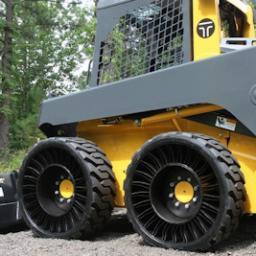Airless tires making inroads, off-road
 If you've never driven a Tweel, it might be time to try one (or four). It is basically an airless tire held up with rubber spokes. Michelin says the spokes provide a unique energy transfer that reduces bounce associated with pneumatic tires while offering two to three times the wear life. And because the tires have no air, you never have to adjust the air pressure or risk getting a flat. Tweels are best suited for low-speed vehicles that don't have suspensions and are prone to flats, such as lawnmowers and skid-steer loaders used on construction sites, but Michelin isn't ruling out their use on other vehicles in the future.
If you've never driven a Tweel, it might be time to try one (or four). It is basically an airless tire held up with rubber spokes. Michelin says the spokes provide a unique energy transfer that reduces bounce associated with pneumatic tires while offering two to three times the wear life. And because the tires have no air, you never have to adjust the air pressure or risk getting a flat. Tweels are best suited for low-speed vehicles that don't have suspensions and are prone to flats, such as lawnmowers and skid-steer loaders used on construction sites, but Michelin isn't ruling out their use on other vehicles in the future. Different companies make tires that don't use air, including Bridgestone and Goodyear, and they go by different names: Non-pneumatic tires (NPT), airless tires, or run-flat tire are the most common. The first time I drove NPT tires was in 2014, I was floored by how the tires absorbed the bumps and seemingly rolled without noise or resistance. The product manager talked about how these "Terrain Armor" NPTs won't go flat (punctures) and won't get stuck in mud because the honeycomb design actually pushes mud out. Of course, they also have some drawbacks, such as noise and vibration at higher speeds.
Run-flat tires use air. They merely have a system - ribs like these tires have, reinforced sidewalls, reinforced tread liners, and/or less commonly a smaller non-pneumatic tire on the inside - to allow them to continue working in some sense when the air is let out, typically through a puncture or leak.
Also, I expect commercial versions on non-pneumatic tires to not be open-air like those pictured. I would expect there to be dangerous situations where rocks could get lodged inside and shot out at high velocities under pressure.
Alright, I'm done griping.